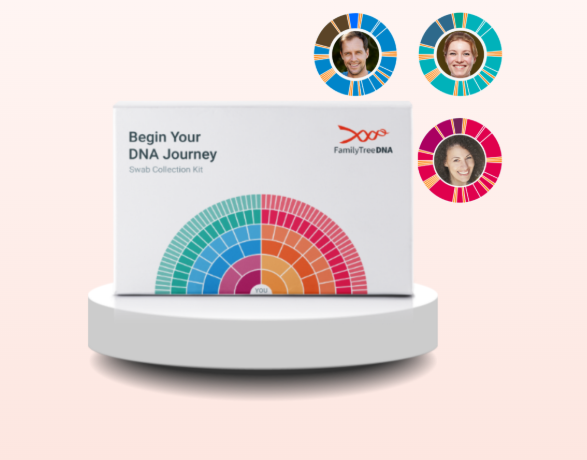How Family Tree DNA Turns Your Genes Into Generations of Discovery
Your DNA holds the map to your past. Discover how Family Tree DNA turns genes into stories using cutting-edge autosomal, Y-DNA, and mtDNA testing.
The story of where you come from isn’t always written in records or passed down through stories and sometimes, it’s coded in your cells. Family Tree DNA is one of the few companies making that science feel personal, accessible, and even kind of cool. With three core test types, autosomal, Y-DNA, and mtDNA, this isn’t just about where your great-grandparents lived. It’s about understanding the molecular footprints your ancestors left behind.
Family Tree DNA breaks ancestry down to its scientific roots, showing you exactly how your DNA connects you to generations past. So if you’ve ever wanted to understand the why behind the results, this is your guide.
How Family Tree DNA Uses Autosomal DNA to Map Your Ancestry
What Is Autosomal DNA?
Autosomal DNA comes from the 22 pairs of chromosomes we inherit from both of our parents and from their parents, and so on. Unlike the Y chromosome or mitochondrial DNA, autosomal DNA blends together pieces from all parts of your lineage. This is the science behind the Family Finder test from familytreedna.
Autosomal DNA testing is designed to reflect recent ancestry, roughly five generations back. The reason? As DNA gets passed down, pieces get shuffled. Some segments vanish, others remain intact. It’s this random recombination that makes you uniquely you and it’s also how genetic tests estimate who your fourth cousin might be.
What the Family Finder Test Reveals
Through Family Tree DNA’s Family Finder test, your autosomal DNA is analyzed to:
- Estimate your ethnic makeup across different regions and populations
- Identify DNA matches from their global database
- Visualize your ancestry using interactive tools like Chromosome Painting
- Offer insights into ancient ancestry with the ancientOrigins feature
This isn’t about vague percentage guesses. Family Tree DNA compares your segments to 90+ reference populations and identifies not just where your ancestors came from, but where specific parts of your chromosomes are rooted.
The Science Behind Y-DNA: Following the Father Line
Why Y-DNA Tells a Different Story
Y-DNA, found only in biological males, is passed from father to son with very few changes over generations. This consistency makes Y-DNA a strong candidate for tracing paternal lineage, something autosomal DNA doesn’t do as effectively.
Testing Y-DNA through familytreedna provides access to your haplogroup, which is like your ancestral tribe. It reveals where your paternal ancestors originated and how they migrated through time and geography.
Y-DNA Test Options from Family Tree DNA
- Y-37: Great for beginners; tests 37 STR markers
- Y-111: Offers greater detail and accuracy
- Big Y-700: The deep-dive DNA test for serious genealogy fans
Each of these options builds on the last, analyzing markers called STRs (Short Tandem Repeats) and SNPs (Single Nucleotide Polymorphisms) to refine your paternal lineage.
What You’ll Learn from a Y-DNA Test
- The surname trail of your paternal ancestors
- Paternal relatives sharing your Y-haplogroup
- Ancient migration maps that trace your father-line over thousands of years
- Connections to early human groups, including insights from Family Tree DNA’s Time Tree
For anyone trying to understand their male-line history or confirm a suspected paternal relationship, a family tree DNA test using Y-DNA offers unmatched precision.
mtDNA: The Silent Story of the Maternal Line

The Unchanging Maternal Line
While Y-DNA is for tracking the father's side, mtDNA (mitochondrial DNA) gives us the key to the mother-line. Unlike the jigsaw puzzle of autosomal DNA, mtDNA remains largely unchanged as it’s passed down from mothers to their children. Only daughters pass it on, making this DNA ideal for following maternal ancestry.
What Family Tree DNA’s mtDNA Test Does
The mtFull Sequence test covers your entire mitochondrial genome. This high-resolution test reveals:
- Your maternal haplogroup, a code linked to an ancient population
- Genetic relatives connected through your mother-line
- Historical migration routes taken by maternal ancestors
What makes mtDNA special is how it links you to deep ancestral roots. We're talking ancient, tens of thousands of years. If you’re looking to map out the long-forgotten journey of your maternal heritage, mtDNA testing with familytreedna is the tool to use.
Why All Three Tests Matter
Most people start with an autosomal test. It’s quick, covers both sides of the family, and provides instant matches. But if you’re building out a serious family tree or just want a complete picture, autosomal only goes so far.
This is where integrating Y-DNA and mtDNA becomes game-changing. Together, the three tests allow you to:
- Distinguish between maternal and paternal connections
- Confirm surnames and generational links
- Identify ancient populations and migration paths
- Pinpoint how you relate to matches within family tree dna’s database
If you've ever hit a wall using traditional genealogy, DNA testing might just crack it open.
Is Family Tree DNA Safe?
One of the most common questions in familytreedna reviews is about privacy. And it’s a valid concern. DNA is personal, maybe the most personal data there is.
Here’s what Family Tree DNA does to protect it:
- You can opt in or out of sharing your matches
- Your raw data is stored securely and only shared with your consent
- In the U.S., laws like GINA (Genetic Information Nondiscrimination Act) protect users from health insurance discrimination based on genetic data
Your results are private by default, and Family Tree DNA’s reputation for transparency has made it a trusted name in genetic testing.
The Value of Choosing the Right Test
Choosing between tests doesn’t have to be overwhelming. Here’s a breakdown:
- Go with Family Finder if you want an overview and relative matches
- Choose Y-DNA if you’re digging into your father's surname line
- Use mtDNA for maternal ancestry going back millennia
And yes, you can always start with one and add more later. Family Tree DNA keeps your sample on file (unless you request otherwise), making upgrades seamless.
And if you’re looking to save, there are often familytreedna coupon codes available that apply to bundles or seasonal promotions making it easier to access your ancestry without overspending.
Your genetic makeup is more than just data points. It’s a living archive of human history, migration, and survival. Family Tree DNA gives that archive a voice, whether you’re just getting started or knee-deep in genealogical records. With their powerful trio of autosomal, Y-DNA, and mtDNA testing, you're not just learning about your ancestry. You’re understanding the science behind it and that’s what transforms a DNA test into a real discovery.
For more on science and family, be sure to follow FlexGlimpse.
Related Blogs
Kushi Beauty’s Whipped Tallow Cream Could Be the Skin Reset You Didn’t Know You Needed
This tallow-based cream from Kushi Beauty is gaining traction in clean skincare. Here’s what’s inside, who it suits, and if it holds up to the hype.
The Truth About SkyRX and FDA-Approved ED Meds Every Man Should Know
SkyRX sells generic ED meds online, but how does it hold up when you dig into cost, legitimacy, and real service details? Here's what surfaced.
The Coziest Sleep Gifts to Wrap Up This Christmas
This Christmas, give the sleep gifts from Manta Sleep. Their sleep masks, earplugs, and white noise machines help your loved ones sleep better. These gifts are perfect for anyone who needs extra comfort. Mantasleep makes it easy to turn every night into a cozy experience.




